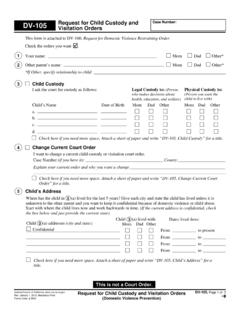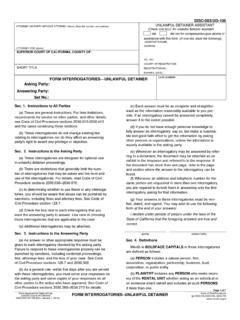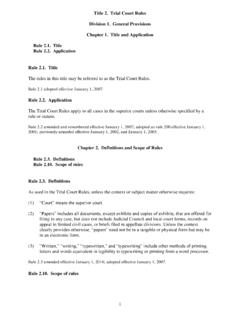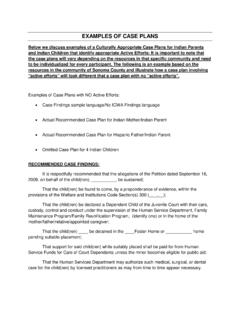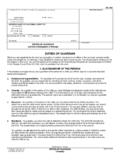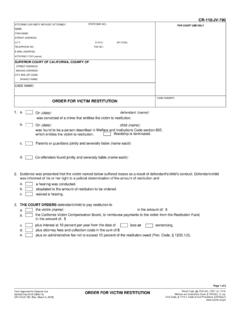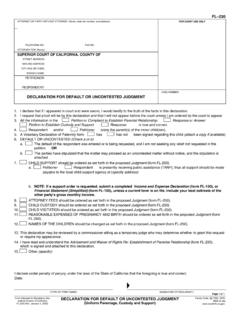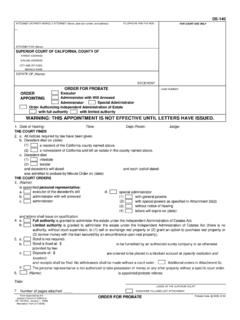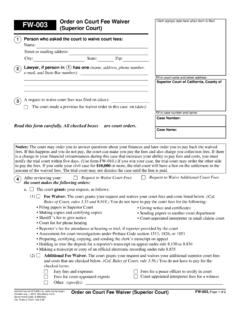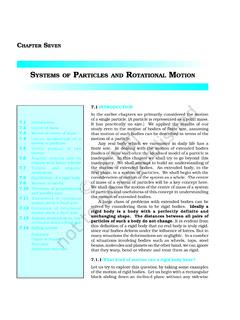Transcription of Class Certification in California
1 Class Certification in California SECOND INTERIM REPORT FROM THE study OF California Class ACTION LITIGATION FEBRUARY 2010 (This page has been left blank for printing purposes.) ii Class Certification in California SECOND INTERIM REPORT FROM THE study OF California Class ACTION LITIGATION FEBRUARY 2010 iii Copyright 2009 by Judicial Council of California /Administrative Office of the Courts. All rights reserved. Except as permitted under the Copyright Act of 1976, no part of this publication may be reproduced in any form or by any means, electronic, online, or mechanical, including the use of information storage and retrieval systems, without permission in writing from the copyright holder. Permission is hereby granted to nonprofit institutions to reproduce and distribute this publication for educational purposes if the copies are distributed at or below cost and credit the copyright holder.
2 Printed on recycled paper This report is also available on the California Courts Web site: For additional copies or more information about this report please call the Office of Court Research at 415-865-7454, or write to: Judicial Council of California /Administrative Office of the Courts Executive Office Programs Division/Office of Court Research 455 Golden Gate Avenue San Francisco, California 94102-3688 iv Judicial Council of California Administrative Office of the Courts (AOC) Ronald M. George Chief Justice of California and Chair of the Judicial Council William C. Vickrey Administrative Director of the Courts Ronald G. Overholt Chief Deputy Director Kenneth L. Kann Director, AOC Executive Office Programs Division Dianne Bolotte Assistant Director, AOC Executive Office Programs Division Dag MacLeod Manager, Office of Court Research Barry Lynch Supervisor, Office of Court Research Ron Pi Supervisor, Office of Court Research Author Hilary Hehman Senior Research Analyst.
3 Office of Court Research v Contents Executive Summary 1 Introduction 3 Background on California Class Certification 4 Overview of Certification Activity 5 Cases with No Certification Activity 6 Motions for Certification 8 Means of Certification 11 Objections to Motions for Certification 12 Challenge of Certification and Decertification 13 Certification by Case Type 14 Certification Time Analyses 17 Case Duration by Case Type 20 Case Duration by Disposition 22 Disposition Analysis 23 Settlement After Certification 24 Analysis of California Data 25 Disposition by Means of Certification 26 Time to Settlement After Certification 27 Conclusion 28 Appendix A Certification Rates Appendix B Certification by Case Type Appendix C Certification Time Analyses Appendix D Disposition Analyses 1 Executive Summary To better understand Class action litigation and its impact on the state court system, the Office of Court Research of the Administrative Office of the Courts initiated the study of California Class Action Litigation in collaboration with the University of California , Hastings College of the Law.
4 The study relied primarily on case file review of a large, random sample of Class action cases drawn from courts across California . This summary accompanies the release of the second report from the study which focuses on a pivotal decision in Class action litigation: Class Certification . Prior to this study , empirical data relating to Class Certification in California was almost non-existent, despite the importance of the decision to the maintenance of a Class action case and the debates that often swirl around its impact on litigation. This report provides the following findings on the subject: Certification Activity Looking at all cases in the database, almost three-quarters of cases filed as Class actions showed no signs of Class Certification activity after some sort of Class reference was put forth the initial filing; The rate of Class Certification (by any means) decreased by more than 50 percent over the study years; Only about 13 percent of study case ever had a motion for Class Certification filed during the life of the case.
5 Forty-six percent of these motions were granted; Most classes are certified as part of a classwide settlement agreement, not through a litigated motion for Class Certification ; Certification by Case Type Employment cases show the highest frequency of Class Certification activity and have the highest rate of classes that are certified as part of a classwide settlement agreement; The higher rate of Certification in employment cases may be because the Certification inquiry is more straightforward for employee classes, perhaps in part because these classes have characteristics that more easily satisfy the standards for Certification . Specifically, employment Class action cases are much more likely to specify a precise number in defining the Class size thus facilitating the definition and identification of the Class ; 2 Certification Time Analyses The median time to disposition for all study cases in the sample was just over a year.
6 The overall median time to disposition for certified cases was almost twice as long; Cases that are certified through a motion for Class Certification have the longest median time to disposition, approximately years. This is a full year longer than the median time to disposition for those certified as part of a settlement; Employment, business tort, and breach of contract cases fall nearest to the overall median time to disposition for certified cases because the median is driven by the most common disposition: settlement. These three case types account for 83 percent of all settlements in certified cases; Considering only cases with a certified Class , cases that settled had the shortest median time to disposition as compared to all other outcomes. The median time is driven by the large number of settled cases in which the Class was certified as part of the settlement itself; Disposition Analyses Eighty-nine percent of cases with a certified Class ended in settlement while only 15 percent of cases with no Class Certification ended in settlement; and Only a fraction of those cases that dispose by settlement with a certified Class are certified through a litigated motion .
7 Instead, the vast majority are certified as part of a settlement. Some of the findings in this report contribute to the debates over Class Certification and settlement pressure. Very few cases can be included in a category in which settlement pressure from Class Certification may have been a factor in the decision to settle because so many classes are certified as part of the settlement itself. In addition, the study finds that neither overall disposition composition nor time-to-settlement analyses can definitively link Certification through litigated motion to inevitable settlement. 3 Introduction The Administrative Office of the Court (AOC), Office of Court Research (OCR) initiated the study of California Class Action Litigation in collaboration with the AOC s Office of the General Counsel and the University of California Hastings College of the Law in order to better understand the impact that this important area of civil law has on California s court system.
8 The project was designed to establish baseline data on the prevalence and nature of Class action lawsuits filed in California . To collect the type of detailed data not normally available through case management systems and overcome the incompatibility of these systems across courts, the project relied primarily on case file review of a large, random sample of Class action cases across the state. In consultation with researchers from the Federal Judicial Center and Hastings Professor Richard Marcus, the Office of Court Research developed a standardized data collection instrument to capture essential data on Class action cases. Student interns from Hastings used the data collection instrument to review individual case files, collect relevant data, and report the information to the OCR.
9 Through this process, the OCR compiled case-level information from more than 1,500 cases filed as Class actions. The OCR then cleaned and organized the collected information into a database for analysis and Specific information collected on both open and closed cases included Number of Class action cases filed; Types of cases and trends in filing over time; Sizes of the classes and Class definitions; Basis of the claims alleged; Internal case events, including motions for Certification ; Duration of these cases; Types of dispositions; Outcome data, including verdict and settlement information; and Fees awarded to attorneys. This is the second of three reports that focus on different aspects of California Class action litigation based on analyses of the case database.
10 The first interim report described general trends in filings and disposition of Class action cases in California and can be found on the California Courts Web site at This second interim report presents the analysis of data pertaining to Class Certification in California , including examinations of case type and disposition profiles for certified cases. The final report will focus on case outcome data. 1 The full study methodology will be set forth in the final, comprehensive report 2 Admin. Off. of Cts., Findings of the study of California Class Action Litigation, 2000 2006: First Interim Report (Mar. 2009) (hereinafter First Interim Report). 4 Background on California Class Certification Class Certification is a pivotal decision in a Class action case.
